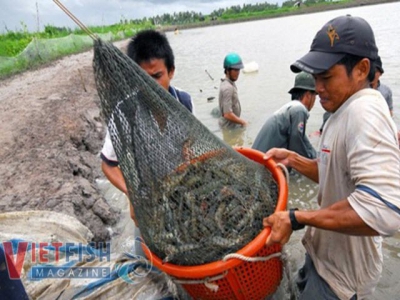Technology 234 to farm shrimps

Businesses are working out optimal solutions to produce successful shrimp crops for adaptation of climate change and sea level rise in the Mekong Delta. Technology 234 by Minh Phú Seafood Corporation is one of them.
According to Chairman of BOD Lê Văn Quang, during its research and development of material shrimp farms, Minh Phú Seafood Corporation experienceda large number of shrimp practices, one of which was technology 234 farm. Not only did technology 234 help produce a bumper shrimp crop but also it could adapt climate change and sea level rise in the Mekong Delta and promised to be possible direction of sustainable development.
Technology 234 means farming in 2 stages, 3 partial harvests and 4 cleanness criteria. Particularly, 2 farming stages include in-pond raceway with diameter of 17.2m where shrimp are stocked within 25-30 days and round pond with diameter of 32m where shrimp are stocked within 70-80 days.
Partial harvest takes place at the first time when farmed shrimps reach 60-65 days old and weigh up to size 60-70 pcs/kg averagely with half of shrimp in the pond being harvested. The second time is carried out when shrimp reach 80-85 days old and weigh up to size 40 pcs/kg averagely with half of shrimp being harvested. The remaining quantity is harvested for the third time when shrimp reach 110-115 days old and weigh up to size 20 pcs/kg averagely.
Four cleanness criteria include SPF shrimp, clean water source, antibiotic free shrimps, and clean environment.
As for clean environment, water must be supplied from the ocean where salinity level is at least 25‰. Water can be re-used after it is treated by natural filter and membrane filter. Sludge siphon at the bottom of the pond must be treated by biogas and the final sludge is used as feed for black soldier flies which then become feed for shrimp or material for protein shake production to make feed for shrimp and cattle.
A complete shrimp farm using technology 234 by Minh Phú must be 8 hectares with 20 floating round ponds D= 32m (approximately to 1,000m2 each) and 10 in-pond raceways D=17.2m with supporting system. The farm may reach average productivity of 2.5 ponds/ha and produces 4 crops/year.
Technology 234 costs averagely 860 million dong/pond (45 million dong on post larvae, 324 million dong on feed, 140 million dong on medicine, 33 million dong on electricity, 52 million dong on salary and 200 million on depreciation). It costs the investor 2.075 billion dong for 2.5 ponds/crop, and 8.3 billion dongfor 4 crops/year.
Revenue from the first harvest may reach 129 million dong, the second 262.5 million dong, and the third 640 million dong. Revenue from 2.5 ponds/crop is 2.578.750 VND and from 4 crops/year is 10,315,000,000 VND. This has resulted benefit after cost of 2,014,996,000 VND per hectare in one year.
Quang said that success rate of Minh Phú have reached over 90% since technology 234 was introduced two years ago. The Corporation believes this is the optimal solution for shrimp farms to adapt climate change and sea level rise in the Mekong Delta.
Có thể bạn quan tâm
 Less is mooring: a fresh approach to fish farm technology
Less is mooring: a fresh approach to fish farm technology An innovative new anchoring technology which could allow Scotland's aquaculture sector to move into high energy marine locations is being developed
 Tra fish prices hit 10-year low
Tra fish prices hit 10-year low Prices of tra fish have dropped to the lowest level in 10 years due to export difficulties
 Pangasius exports will grow thanks to EVFTA
Pangasius exports will grow thanks to EVFTA Pangasius exports to some key markets in the first half of 2019 decreased. From the third quarter, pangasius exports are forecast to expand again.